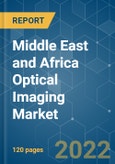The Middle-East and African optical imaging market is expected to witness a CAGR of 7.2% during the forecast period (2022 - 2027). Optical imaging is an emerging technology with great potential for improving disease prevention, diagnosis, and treatment in the medical office or in the operating room. The pandemic witnessed a downward growth in the demand for optical imaging devices as most of the new ventures and surgeries were postponed to contain the spread of the COVID-19 virus.
The Middle-East and Africa Optical Imaging market is moderately fragmented and consists of several major players. In terms of market share, few of the major players currently dominate the market. However, with innovative and sustainable packaging, many companies are increasing their market presence by securing new contracts and by tapping new markets.
This product will be delivered within 2 business days.
Key Highlights
- Optical imaging offers the potential to differentiate between soft tissues and between the affected tissues. This ability of optical imaging to differentiate between the healthy and infectious tissues creates a huge opportunity in the medical diagnosis industry.
- The growing concerns over eye surgeries in the Middle-East and African countries have further increased the application of optical imaging in ophthalmologic diagnosis. Optical imaging uses non-ionizing radiation, which significantly reduces patient radiation exposure compared to other harmful effects of radiation-based imaging.
- However, the market growth is restricted by factors such as stringent regulatory approval procedures, high costs of instruments, scarcity of skilled operators, and insufficient reimbursements policies for the optical imaging procedures.
Key Market Trends
Ophthalmology to Show Significant Growth
- The region is also witnessing some historic diagnoses being performed in this field which further suggests the growth prospect of the market in the Middle Eastern region. For instance, in November 2021, the ophthalmology team at Sheikh Shakhbout Medical City (SSMC), one of the UAE's largest hospitals for serious and complex care and a joint-venture partnership between Abu Dhabi Health Services Company (SEHA) and Mayo Clinic, performed the first intelligent eye implant with the eyeWatch device to save the eyesight of patients affected by glaucoma.
- Several leading pharma giants are collaborating with eye hospitals and channel partners in the studied market to capitalize on the growing demand for ophthalmological products. For instance, in September 2021, NTC granted STADA a license and distribution rights for certain proprietary ophthalmic products in the region, intended to address several ophthalmic diseases, in particular blepharitis, dry eye, and allergy.
- Bayer Middle East introduced its Alleye Home Monitoring Sponsorship Program to the Egyptian healthcare sector. It is working with the country's top-rated eye hospitals to support Egypt's ophthalmologists in the new era of virtual care for patients with either Diabetic Macular Edema [DME] - a complication of diabetic retinopathy - or age-related macular degeneration [AMD].
Hospitals to Hold the Highest Market Share
- Most of the countries in the Middle Eastern region have state-funded healthcare systems. Countries such as Bahrain have established National Health Regulatory Authority to ensure its procedures and standards are consistent with the newest innovations.
- Qatar, on the other hand, spends 2.2% of its GDP on healthcare annually. It has a public healthcare system that offers free and subsidized services to residents and citizens. Around 90% of Qatar’s population utilizes the public healthcare system, while the remaining populous utilizes private healthcare.
- The region is witnessing several strategic acquisitions to capitalize on the increasing demand for dermatology and dentistry care. For instance, in March 2021, Amanat Holdings - a company based in the United Arab Emirates (UAE) that invests in healthcare and education - fully acquired the local rehabilitation institute, Cambridge Medical and Rehabilitation Centre (CMRC), for an enterprise total of USD 232 million (GBP 166m).
Competitive Landscape
The Middle-East and Africa Optical Imaging market is moderately fragmented and consists of several major players. In terms of market share, few of the major players currently dominate the market. However, with innovative and sustainable packaging, many companies are increasing their market presence by securing new contracts and by tapping new markets.
- December 2021 - Israeli startup Ophthalmic Sciences Ltd is targeting 2023 for regulatory clearance of its artificial intelligence (AI)-based contactless intraocular pressure (IOP) measuring device, IO Perfect. The technology, which combines AI visual analysis in a virtual reality headset, enables remote monitoring of glaucoma. The device is designed to be used at home, in eye clinics, emergency room departments, pharmacies, and primary physician settings.
Additional Benefits:
- The market estimate (ME) sheet in Excel format
- 3 months of analyst support
This product will be delivered within 2 business days.
Table of Contents
1 INTRODUCTION
4 MARKET INSIGHTS
5 MARKET DYNAMICS
6 MARKET SEGMENTATION
7 COMPETITIVE LANDSCAPE
Companies Mentioned (Partial List)
A selection of companies mentioned in this report includes, but is not limited to:
- Abbott Laboratories
- Bioptigen Inc.
- Carl Zeiss Meditec AG
- ChemImage Corporation
- Headwall Photonics Inc.
- Cytoviva Inc.
- Topcon Corporation
- Heidelberg Engineering Inc.
- Canon Inc.
- Leica Microsystems
- Optovue Inc.
- Perkinelmer Inc.
Methodology

LOADING...








